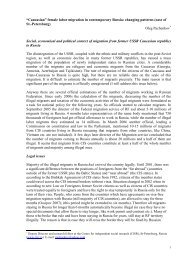THORIUM AS AN ENERGY SOURCE - Opportunities for Norway ...
THORIUM AS AN ENERGY SOURCE - Opportunities for Norway ...
THORIUM AS AN ENERGY SOURCE - Opportunities for Norway ...
Create successful ePaper yourself
Turn your PDF publications into a flip-book with our unique Google optimized e-Paper software.
Thorium as an Energy Source - <strong>Opportunities</strong> <strong>for</strong> <strong>Norway</strong><br />
5.2 Properties of the Fissile Material Uranium-233<br />
The fission cross section of U-233 is comparable to that of U-235 in the thermal neutron energy<br />
region. However, there are resonances above an energy of around 1eV (Figure 5.4). This has to be<br />
considered if shifts in the spectrum during massive transients in a thermal reactor are regarded.<br />
U-233 exhibits further fission and absorption resonances in the epithermal energy region which<br />
could influence the dynamic behaviour of a reactor loaded with large amounts of Th-232 and U-<br />
233. Like other fissile materials, U-233 has a small fission cross section at high energies.<br />
Figure 5.4: Fission Cross Sections of the Isotopes Uranium-233 (U-233), Uranium-235 (U-235) and<br />
Plutonium-239 (Pu-239) in the Thermal Energy Region.<br />
The uranium isotope U-233 has very attractive features as a fissile material especially in the<br />
thermal energy region. For thermal neutron energies, U-233 has a higher η-factor than U-235<br />
and Pu-239 (Figure 5.5). The η-factor is the number of neutrons produced per neutron captured<br />
by the fuel, defined by the expression:<br />
40<br />
Figure 5.5: The η -Values of U-233, U-235 and Pu-239.

















